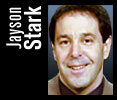 |
| Tuesday, January 7 Updated: January 8, 1:55 PM ET No respect for the best of the '80s By Jayson Stark ESPN.com |
|||||||||||||
|
After perusing the results of another fascinating Hall of Fame election, I had this question: Did the '80s really happen? Most of the great stars of the 1950s and '60s and '70s had no trouble getting elected to the Hall of Fame. But it's amazing how tough it's been for the men who dominated the '80s. Let's tick off the names: Andre Dawson, Dale Murphy, Ryne Sandberg, Goose Gossage, Bruce Sutter, Lee Smith, Jim Rice, Jack Morris, Don Mattingly.
Does anyone really have any doubt they were among the best players of their time at their positions? Yet they're all stuck in the scariest kind of Hall of Fame limbo -- too good to get lopped off the ballot, not highly esteemed by enough voters to be an imminent threat to get elected any time soon. A friend of mine made that observation this week, and it got me to thinking how right he was. The '80s were a turning point in baseball. Numbers changed. Rotations suddenly added a fifth man from coast to coast. Managers began drawing up formulas for when they would and wouldn't use the monster we've come to know as "the closer." And by the time the '90s came along, this was practically a whole different sport. So think how tough that's made it to accurately evaluate what went on in a decade when teams like the Royals and Tigers were actually perennial contenders. First off, if you're a voter gazing back at those '80s hitters through 2003-colored Oakleys, it starts to look as if nobody was any good. How many second basemen nowadays put up Ryne Sandberg numbers? Ten? Twelve? So Dale Murphy averaged 30 homers and 93 RBIs a year back then, huh? We counted 24 different players -- including four middle infielders -- who had a season like that this year. So Andre Dawson averaged 20 homers and 20 steals a year for the whole decade, eh? Barry Bonds averaged 30-30 in the '90s. And it wasn't just the hitters who changed. In the last year of the '70s, only three pitchers in the whole sport saved 30 games. By the first year of the '90s, Bobby Thigpen was saving 57. In 1980, Steve Carlton had to pitch 304 innings to lead the National League in innings pitched. Ten years later, with the five-man rotation as firmly entrenched as the hit-and-run, Frank Viola didn't even have to pitch 250. So when we look at Morris' 254 career wins, are we measuring him against Tom Seaver and Jim Palmer and Carlton? Or are we measuring him against the other pitchers of his day? And when we attempt to evaluate the save numbers run up by Smith and Gossage and Sutter, do we think about how cheap saves are today, or do we gauge them against the relievers of their time? Well, if we're measuring all of these men against the people they played against, they ought to be working on their Cooperstown acceptance speeches right now. Or at least holding their breath every year on the first Tuesday in January. But obviously, that's not happening -- or else Murphy's vote totals wouldn't be sinking like the Andrea Doria. So it's an intriguing process, all right. Now, if someone can please explain how Danny Tartabull got a vote, we can start solving our next Hall of Fame mystery. Jayson Stark is a senior writer for ESPN.com. |
| ||||||||||||


